Juicy breasts, plump thighs, a tight bulging buttocks … are we talking about a woman’s body or dinner at a steakhouse? It could be either. The language used to describe the body parts of women versus that of non-human animals are often separated by a slim differential in terms of the poetic license taken. Both are seen as something that can be consumable. One breast laden with turkey gravy and the other (often in pornography) laden with a thick human bodily fluid also referred to as “the gravy.” Am I being graphic here? Yes. Why? To make a point. When we refer to living creatures in such a way, we create a chasm between what is real, what is honest, what is life, versus what is a fantasy, what is entitlement, and what is one’s “right” to have/consume. Who is doing all of this having and consuming? Men – most often white men…. The patriarchy feasts once again!
Women are often objectified sexually. We see this objectification in advertisements, magazines, commercials, movies, social media, and in pornography. They are captured in a light designed for the male gaze. After all, as Lisa Kemmerer stated in her evaluation of Carol Adam’s work, “When we want perfection, we know where to look: white male civilization, category A” (Kemmerer, 1). Category “A” refers to a list comprised of the characteristics society looks to which are considered “good and powerful” which includes “Man/Male, Culture, Human, White, Mind, Civilized, Production, Capitol, and Clothed” and those things in opposition (dualism) which would be Woman/Female, Nature, Nonhuman Animal, People of Color, Body, Primitive, Reproduction, Labor and Naked” (Kemmerer, 1). See a pattern here? Anything “other” than those characteristics/identities in column A are “other” and often those identities are affiliated with people classified in oppressed groups.
Let’s move on to nonhuman animals and how they are portrayed in advertisements. As we can see from the images below, they are often sexualized in the same way that women are. They are there for someone’s consumption. They exist in order to satisfy someone else’s desires, fantasies, and appetite. Their rights, their role in society, their lives are not their own. As Carol Adam’s said, “Meat is like pornography: before it was someone’s fun, it was someone’s life” (Kemmerer, 2). I think this is an accurate observation with the emphasis placed on the word “life”. The objectification of nonhuman animals makes killing and consumption more palatable. The “life” part of the equation literally and figuratively dies.
Following are a few advertisements that were utilized in Carol Adam’s “The Pornography of Meat”. Let’s analyze the ways in which these ads ratify the ideologies that society has fallen prey to in terms of what is perceived as normal when it comes to the treatment of women and nonhuman animals in advertisements pertaining to the consumption of meat and/or nonhuman animal products. 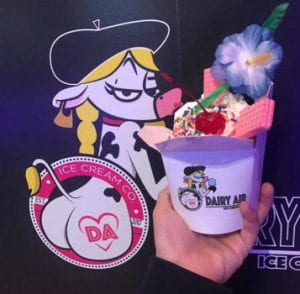
I must admit, at first glance, I didn’t even notice the ice cream in this ad. My eye went immediately to the bright pink ring which framed the human buttocks …. Oh, wait it has a tail… the nonhuman buttocks … oh wait it has braids and a beret … it is a human…. no wait it has black markings like a cow… it’s a nonhuman, right? Wait what?!!!! Exactly! Who is even looking at the ice cream at this point? This is a sexualized cow made to look like a “sexy” woman. I must be honest, when I showed this ad to my husband his response was that “this is weird and rather disturbing”, whew – glad we agree on that! This cow is selling sex. The ice cream (aptly named Dairy Air) is secondary. This is a perfect example of what Carol Adams refers to as anthropornography. “Anthropornography means the animals (usually species of animals presumed to be literally consumable are presented as sexually consumable, in a way that upholds the sexual exploitation of women” (Potts, 14). This cow in this ad meets those criteria. This ad does three very specific things. First, it uses language to manipulate the message. The name Dairy Air is a play on words for the word derriere which is used to emphasize the buttocks of the cow. Secondly, it fragments the cow, which is to say it is separating the cow from its true nonhuman animal identity. Lastly, it portrays the cow in such a way that it is seen as sexually consumable and that the product that it helps to create is also consumable. This ad is interesting to me because it blurs the line between the consumption of the product that the cow provides (milk into ice-cream) and the cow itself.
A lot of the same concepts from the first ad apply to this second one by sexualizing the turkey. They placed a woman’s bra and underpants on a cooked, decapitated carcass. We cannot ignore that this is also implying that women are meat and therefore, consumable. Carol Adams said, “For women, through pornography, their degradation is always already sexy. The sexualization of animals and the sexual objectification of women thus overlap and reinforce one another” (Potts, 15). This ad is a perfect example of this type of overlapping. This ad draws attention to the breasts with the largest percentage of meat eaters consuming it at an overwhelming 60%. (Are you a breast man or a thigh man?) This ad also takes things a step further by stating, “The darker the meat, the sweeter the taste” which I can only perceive as a racist and sexist comment angled at women of color. We also have the breakout of what kind of meat people prefer with white (meat) at 82%, dark (meat) at 15% and tofu (non-animal) at 3%. This hierarchy (based on the percentages of popularity) of meat by identity/class is the perfect example of intersectionality in an ad. The idea that by virtue of human vs non-human and then by color, you are somehow put into a category based on the choice of what meat people like the most versus the least, is classic patriarchal classism, sexism, racism, and speceisism. Of course, white meat leads the pack, putting dark meat second but at least it didn’t lose because the big loser here is the tofu. The plant-based option of course loses.
I find this last ad to be the most disturbing one. I was immediately struck by its violence and was not going to use it for my blog. There is a Buddhist belief that goes something like this – we must examine and understand those things that cause in us such a reaction that is upsetting. We must look at those things for understanding for it is there that we will find understanding within ourselves. So, let’s do this. First, I see a bloodied woman. I see her hanging by a hook. Then I realized of course it is a cow’s dead carcass. I am drawn to the women’s sexy clothing adorning the meat. Then the slogan, “It’s Not Acceptable to Treat A Woman Like One” and below that in very fine print it says, “Most men agree, but few speak out. Please. Be Heard. A man’s voice is an effective way to change demeaning societal attitudes towards women.” In the corner there is a logo for The Coalition Against Domestic Violence. Lots to unpack with this one.
First off, I understand the feelings that they are trying to evoke with this image. I understand it is supposed to be a violent one. Job well done, but at whose expense? Violent to and for whom? The ad is meant for men. It is meant to catch the attention of men as it is designed to deliver a message to men. Don’t treat a woman like a piece of meat…. like an animal…like property. If that is the message, what does that say about how we treat animals? So then treating an animal this way is ok but don’t treat a woman this way? I can’t help but hear Carol Adams here saying, “That appears superficially as substitution is actually the layering of one oppressive system on top of another” (Potts, 20). While trying to deliver a message about violence against women, we are making it clear that there is a hierarchical system here that values one species over another. It is placing women (humans) in opposition to nonhuman animals as a way of establishing value by and between animals.
Let us also address the way in which the carcass is clothed and sexualized. Is the sexualization of a cow necessary in advertisements about domestic violence? What is that about? Even here they saw the need to sexualize the woman/cow in this ad. It is hard to tell where the woman ends, and the cow begins here, once again echoing the earlier mention of overlapping. I feel the clothing choice takes the intended message and soils it, retracts from it, and honestly serves as an opposing force to the message by further ratifying how certain men see women. It is playing into the very things that domestic violence should oppose, the degrading way in which men see women and how they treat them.
When Carol Adams discusses the use of meat in art, she makes an astute observation that I believe applies here. She said, “A species-specific privilege creates the space in which art that uses the abject bodies of dead animals exists and can be protected. When something specific like killing has an ethic that stops at the species line, I want to know why…” (Potts, 22) and I think this applies to this ad. Some might say it is artistic. We can argue that the law protects it – but why? There were many other ways that the message in this ad could have been delivered. The choice of image is deliberate as the audience for this message is men and men alone.
I would like to look at one last advertisement that I found. It caught my attention for several reasons. Take a look:
This advertisement is for a cooking site Le Cornichon. The recipe that they are advertising is “Goose Leg Confit With Parsley.” Once again, we have an animal comprised of part human (woman) and part animal. The two are enmeshed. The duck head is adorned with a hat cheekily topped with parsley. The goose legs are lovely long human legs with garter belts and lace thigh high stockings. The human/nonhuman figure is wearing a time period style undergarment. It invokes a rather regal French Victorian vibe with a side of sexism, racism, classism, and speciesism. It is quite the banquet of objectification. I almost felt like they were trying to “class it up” so to speak but it lands (for me) as extremely strange and a disturbing cacophony of “ick.” Are we so removed from the fact that this is advertising a dish for goose legs that we forget we are going to eat a goose leg? Objectify the nonhuman enough that we no longer see it as a living being and therefore, we can dine guiltlessly on its meat. On the other hand, are we supposed to find it sexy and think about consuming both the woman and the goose? You get where I am going here. Both are consumable. The audience is very specific here. The appeal of this image is thin, white, European, affluent (royalty), type of indulgence. This image oozes feelings of privilege and the fruits of life that come from it. “Privilege protects itself” and the continual cycle of that is evident through the intentions of those relaying the messages and the lucky recipients of them (Potts, 19).
I want to share something with you all that popped into my head while writing this blog. Years ago, there was a cookbook that came out called “Fifty Shades of Chicken” which was a parody of the book/movie “Fifty Shades of Grey”. The entire cookbook objectifies chicken. If you go onto Amazon you can flip through some of the sections with titles such as “Extra-Virgin Breasts”, “Popped-Cherry Pullet”, “Pound Me Tender”, “Hot Rubbed Hen” – you get the idea. The cover of the cookbook bears the image of a cooked chicken tied up in bondage. I think we could do an entire blog on this cookbook alone.
“Eating The Other”, bell hooks
“Certainly from the standpoint of white supremacist capitalist patriarchy, the hope is that desires for the “primitive” or fantasies about the Other can be continually exploited, and that such exploitations will occur in a manner that reinscribes and maintains the status quo” (hooks, 367).

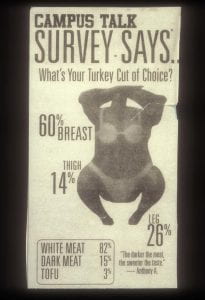
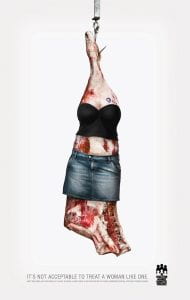
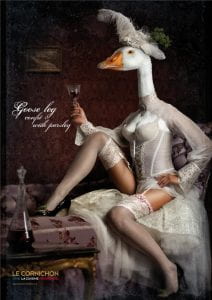
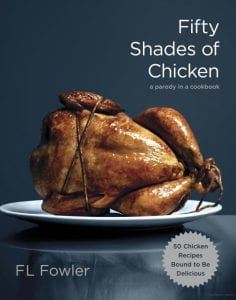
Interesting Update to the “Dairy Air” graphic and controversy. I am not including the link to the company since it may not pass the “filter” but..
Dairy Air Ice Cream’s Owners Are Tweaking Controversial ‘Sexy’ Cow Packaging
By Taylor Rock|Dec. 14, 2017 3:51 pm EST
A New Jersey-based ice cream parlor is making changes to its packaging after receiving community backlash over the brand’s cartoon logo — a seductive-looking pink cow in pigtails, braids, and a beret with a prominent rump branded “DA” within the confines of a heart. The shop’s marketing strategy and social media presence rely heavily on posterior puns. Some menu items are called: “Peppermint Fatty,” “Oprah’s Favorite Fanny,” and “Muffin Top Money Maker.” The new Dairy Air graphic is a typical ice-cream sandwich. It gives me hope to see that even waaaay back in 2017 the company received enough criticism to change their marketing strategy.
I am glad that you included the “hanging piece of meat” graphic. it is powerfully provocative. Perhaps the intensity of the picture and its message require this level of overt, advertising.
Best!
Catherine
Thanks Catherine! I appreciate the update about the “Dairy Air” advertisement. It gives me hope that some companies (when called out) will consider re-branding. Even if they don’t agree with it – they are responding to the push back and taking action. Hopefully others like them will follow suit.
The hanging piece of meat was a tough one for me. While it certainly caught my attention and sent a STRONG message, I think part of the message got lost for me in its presentation. I agree that it is powerful!
Thank you once again for your response! 🙂
Hi Teresa,
I would first like to point out how incredible your opening paragraph was, it not only drew me in as a reader with your writing style, but also explicitly pointed out the overall message of this week’s material, patriarchy works to feast on the objectification of women and non-human animals. The second image you choose bewilders me all together. Why this is featured in a Campus Talk survey is quite disturbing and the choice of wording and visuals is just as appalling. I appreciate that you pointed out the sexualization and feminization of the dead turkey carcass, it clearly works to insinuate that this survey is not necessarily only working to “rate” meat consumption preference, but also has undertones of ranking the “taste” men have in their women. As white heteronormativity is favored in patriarchy, it is to no surprise that this survey ranks white meat at the highest percentage but then must throw in the racist comment to justify the demeaning of people of color. In connection to objectification of the body, breast meat is the most preferred both in non-human animals and human women. Although the poster reads it’s a survey on turkey meat, it is clearly a women-nature connection as the turkey body is clothed in a feminine two-piece with the turkey wings posed behind the neck as if posing for the pleasure of what Adams calls, “the arrogant eye.” In another work of Adams titled, “Neither Man nor Beast,” she writes of this disconnect as an “…aspect of what constitutes human male subjects against human female objects, and contributes also to constituting scientific subjects over the other animals” (Adams 18). In other words, the male perspective holds control over other forms of life as they are viewed as consumable objects to be ranked by preference. Adams further states that making a subject into an object through depictions and representation “enables conceptualization in which the subject-object dichotomy recurs: looking at representations provides the gazer with pleasure while simultaneously reinforcing the distance between subject and object unbridgeable” (Adams 18). I found this to be such a powerful quote to relate to your analysis of this second image, or all anthropornographic images as the actions of animalization, feminization, and sexualization all work to make the disconnect between not only non-human animal and human stronger, but also to set apart male desire from that of all subjects. In this image in particular, the turkey is feminized as a representation for the male gaze. It reinforces the distance between subject and object as we no longer see the turkey as a life once living. The feminine clothing used to picture a woman’s body without literally placing it in the visual. One being literally ranked for consumption while the other being figuratively ranked for consumption, both by the “arrogant eye.” This can apply to each of the images in the slide show as hegemonic masculinity is at the center. Your own selection of image even reproduces this hierarchy of maleness as a goose is feminized and sexualized through a cooking advertisement while the woman is animalized. Goose is considered a delicacy meat in most countries, by representing an advertisement with a feminized goose garnished with parsley insinuates the message that meat is just as much a delicacy as the female body and if you indulge in the consumption of this product then you will feel regal and superior, just as a male should in patriarchy. As I continue to find more and more examples of anthropornography everywhere, it becomes clear that this is not a dominant problem in past advertisements but one that continues. Without recognition that we are all the same species, and all deserve to have our lives valued, androcentrism will continue to plague society granting consumption and exploitation for generations to come.
If you’d like to read more into the additional Adams reference here is the citation information:
Adams, Carol J. Neither Man nor Beast: Feminism and the Defense of Animals. Bloomsbury Academic, an Imprint of Bloomsbury Publishing, 2018.
Best,
Kylie Coutinho
Kylie –
Thank you so much for the positive feedback! I especially appreciate the care and detail you took in responding. I will check out “Neither Man Nor Beast” per your reference. I didn’t think about the fact that goose is considered a delicacy and how that plays into the overall feel of the message being delivered. Good catch!
T
Hi Teresa,
I must say, much like Adams, you have a similar dry wit and clever tone that only emphasizes the ridiculousness of our patriarchal “right” to consume. You write, “Am I being graphic here? Yes. Why? To make a point. When we refer to living creatures in such a way, we create a chasm between what is real, what is honest, what is life, versus what is a fantasy, what is entitlement, and what is one’s “right” to have/consume. Who is doing all of this having and consuming? Men – most often white men…. The patriarchy feasts once again!” and I have to admit, I was a little disappointed that I didn’t come up with that myself. Especially once I got the conclusion of your piece and realized we picked the same Fifty Shades of Chicken image to analyze (great minds!)
But, you’re right. It all comes down to entitlement, privilege, and those who are sitting bibbed at the head of the table, fork and knife in hand, ready to carve up whatever suits their fancy…woman or animal.
In their scholarly piece “Is Meat Sexy? Meat Preference as a Function of the Sexual Motivation System,” writers Chan and Zlatevska examine the way in which our patriarchal perspective of meat has exacerbated men’s preference for meat. Through a scientific lens they present how “meat signals status to others” and consequently, “men’s desire for status mediates their liking for meat” (Chan). The break it all the way down to how men’s sexual motivation system is now linked to meat eating. Our oppressive and dominating propagandized perception of animals as “meat” to be consumed has altered the sexual chemistry of mens’ brains. This system has gone so deep that it’s hard to imagine a world in which it can be reversed. Especially when we view images like the “Dairy Air” one that you included in your post, where the animalization of women and, conversely, the sexualization and feminization of animals is on full display, and we think it’s completely normal—funny even!
The conversational tone that you used to frame your writing not only made the information accessible but also made it approachable. Those with privilege will go into your points with an open mind. Hopefully, this is the key to dismantling the dominating and oppressive system we find ourselves in— honest conversation and a critical look at our surroundings.
All the best,
Jas
Works Cited:
Chan, Eugene Y., and Natalina Zlatevska. “Is Meat Sexy? Meat Preference as a Function of the Sexual Motivation System.” Food Quality and Preference, vol. 74, 2019, pp. 78–87.
Jas –
I am flattered that you compared my tone/voice to that of Adams. How amusing that we both picked the same cookbook! Your statement, “This system has gone so deep that it’s hard to imagine a world in which it can be reversed” is quite poignant. We are conditioned to so many unhealthy norms. When we start to really examine things and see the truth once exposed, it is hard to then “un-see” it.
T
Hi Teresa,
I enjoyed reading your post, and you illustrated many of Carol Adams’ points in a way that made them easy to understand. I was especially interested in the advertisement for Nandos that you highlighted. In this advertisement, part of the “joke” in the narrative is the blond customer is so unintelligent that she cannot see past her breasts to the food on her plate. The narrative is framed to indicate that it is acceptable to laugh at this woman because of her perceived unintelligence. In this way, the woman’s humanity or societal value is lowered because of a characteristic we assign her. I believe that this type of logic connects strongly to a point Adams made about how society judges the value of non-human animals.
According to Adams, there is debate about whether the suffering of animals is most important or the fact that animals are killed in the meat industry. For Adams, the issue of whether animals are suffering is immaterial to the debate of whether they should be given rights. Adams states, “Nonhuman animals matter because of who they are — individual beings — not because of a certain quality that obtains to them (their suffering)” (as cited by Potts, 2010, pg. 14). It is pointed out by Adams that discussing suffering as a precondition of rights is something that we only do for non-dominant groups, such as women and non-human animals.
In the Nando’s advertisement, we can see this logic of hierarchy and its connection to judgment of value clearly. The woman’s right to dignity is disregarded because of the quality of her intelligence, and the chicken’s rights are disregarded because of its non-human status. Thus, this advertisement proposes the logic that rights are not inherent to beings. Instead, the quality of rights granted is somehow connected to the ability of an individual to display certain characteristics. Advertisements like this encourage viewers to find humor in this type of logic and work towards normalizing the idea that rights are earned and not inherent.
Potts, A. (2010). “The politics of Carol J. Adams.” Antennae, (14). pp.12-24. https://static1.squarespace.com/static/54792ff7e4b0674c74cb719d/t/55dc8dace4b0ad76d7277cb7/1440517548517/ANTENNAE+ISSUE+14.pdf
Jennifer –
Your comment that, “rights are not inherent to beings” pretty much sums up EVERYTHING we are learning. Sadly, even when things are changed on paper (laws, policy, etc.) , often times the ideology that exists prevails and prevents true progress.
Teresa
Kudos, Teresa – you went bold in this post, and it worked! This lesson has so many layers to it, so many taboo things, and you managed to gracefully discuss them all. Let me start with the newspaper ad with the turkey on it. I had this on my list to take a closer look at, as it struck me as an incredibly disturbing image. The idea of a bathing suit on a turkey, or a turkey having tan lines, was bizarre.
“A process of objectification/fragmentation/consumption objectification/fragmentation/consumption connects women and animals in a patriarchal culture (they become overlapping absent referents). The visual “joke” that substitutes one fragmented object for another can be found throughout our culture” (“The Politics of Carol J. Adams,” 2010, 13). We see this with the “joke” of the tan-lined turkey and then further, with the breakdown of what body part people prefer; breast, thigh, or leg. This exactly supports what Adams speaks of when she shares “Women are animalized and animals are sexualized and feminized” (“The Politics of Carol J. Adams,” 2010, 13).
Similarly, I initially took a closer look at the dressed animal carcass on a hook. As I tried to understand what it was advocating, I couldn’t actually see how it was advocating for anything. It’s as if the entire ad continues to support what we can now see as a lack of ecofeminism in regard to women, the environment, animals for protein consumption, and the sexualization of women and animals. The conundrum deepens as it’s an ad for the Coalition Against Domestic Violence, when all is seems to be doing is further endorsing it.
Thank you for having the courage to really dive in and discuss what is happening in these disturbing images. As you share, looking at and talking about what is happening is one of the ways that we can start to change not only the images that we see in mainstream media, but initiate change in the heteronormative, patriarchal domination in our society.
The Politics of Carol J. Adams. (2010). Antennae, 14, 12–24. https://static1.squarespace.com/static/54792ff7e4b0674c74cb719d/t/55dc8dace4b0ad76d7277cb7/1440517548517/ANTENNAE+ISSUE+14.pdf
Hi Teresa! I agree that being graphic will many times bring people to open their eyes to situations and injustices. I grew up in the conservative south so when it comes to sex and porn I am pretty much a prude, it hasn’t been until the last couple of years where I have began to open my eyes to the fluidity of sexuality especially within myself and I found it very thoughtful how you integrated the production and word usage in pornography and how it aligns with the meat industry. And as a whole it just oozes the intention of stripping away any dignity that women and animals have. You stated that non human animals are portrayed in advertisements in accordance to the likeness that women are sexualized. You bring up a great point about that similarity. Do you think that animals are sexualized in this way because the advertisers are creating their marketing with the thought process that men are only responsive to sex? If this is true this would significantly show the level of intelligence that the advertising world think men have. I am not at all calling men unintelligent, what I am saying is, is seems like the masculinity of men is based on how rampant their sexual response is. And in order to get men to buy (because men inhabit the majority of the wealth in this country) they have to appeal to their masculinity and in order to do that, it seems that their sex drive has to be in hyperdrive even when it comes to food. And that is why advertisers are working so hard to align food with sex in the same manner that women are sexually objectified in almost every marketing avenue.